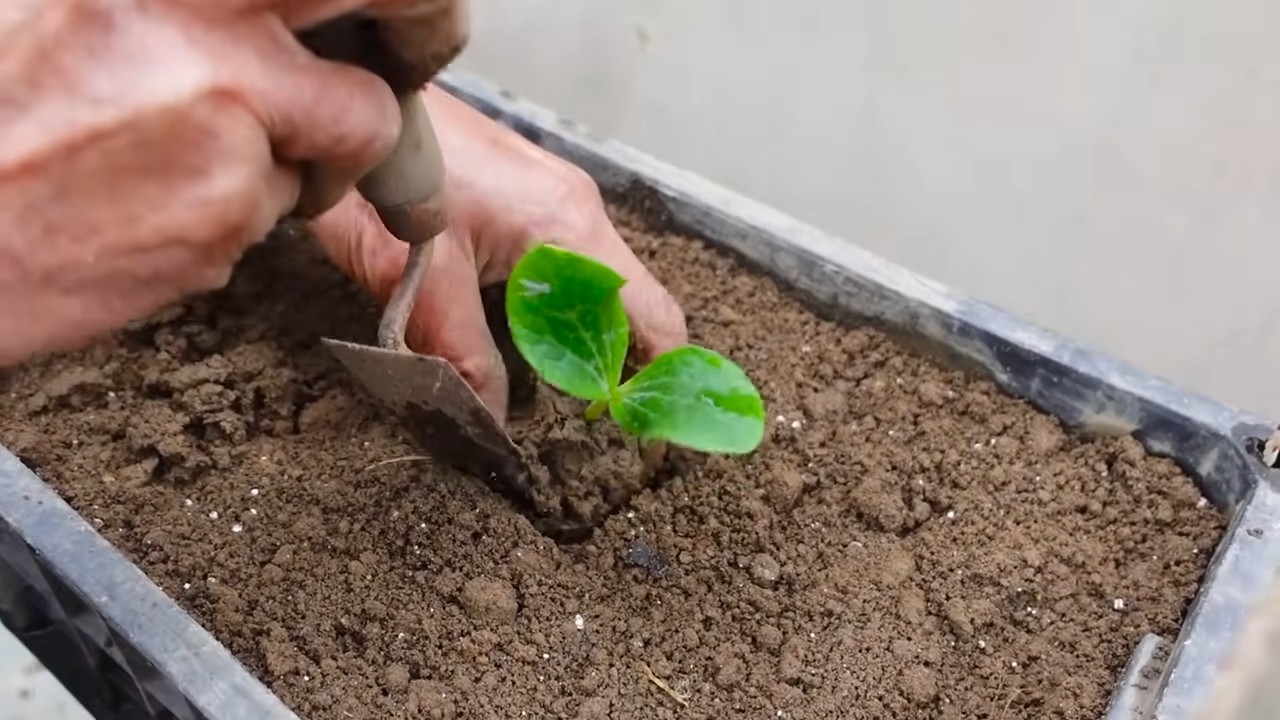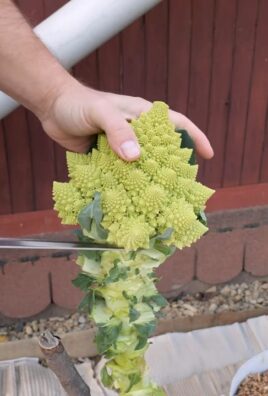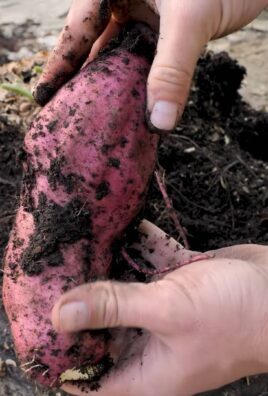Grow Zucchini at Home and unlock a world of fresh, flavorful possibilities right in your backyard! Have you ever dreamed of harvesting your own vibrant, green zucchini, ready to be transformed into delicious meals? Well, stop dreaming and start doing! This DIY guide is packed with simple, effective tricks and hacks that will empower you to cultivate a thriving zucchini patch, even if you’re a complete beginner.
Zucchini, a member of the squash family, has a rich history, with its origins tracing back to Central America. While the zucchini we know and love today was developed in Italy, its ancestors were cultivated for centuries by indigenous populations. From hearty stews to delicate fritters, zucchini has become a culinary staple worldwide.
But why should you bother growing your own? In today’s world, knowing where your food comes from is more important than ever. Store-bought zucchini can sometimes lack flavor and freshness. Plus, growing your own allows you to control the entire process, ensuring you’re using organic methods and avoiding harmful pesticides. Imagine the satisfaction of serving a meal made with zucchini you nurtured from a tiny seed! This DIY guide will show you how to grow zucchini at home successfully, saving you money, reducing your carbon footprint, and providing you with a bounty of delicious, homegrown goodness. Let’s get started!

Growing Zucchini Yourself: Your Comprehensive DIY Guide for a Bountiful Harvest
Hello, gardening friends! I love zucchini—they’re versatile, delicious, and grow like crazy when you give them the right care. In this article, I’ll show you how to easily grow zucchini at home, whether you have a large garden or just a small balcony. Let’s get started!
What You’ll Need: Preparation is Everything
Before we begin, let’s make sure we have everything we need. Here is a list of the materials and tools you’ll need for growing zucchini:
- Zucchini seeds: Choose a variety that you enjoy and that is suitable for your region. There are many different types, from classic green zucchinis to yellow or round varieties.
- Seedling pots or trays: For starting seeds indoors.
- Seed starting mix: Special soil for starting seeds that is low in nutrients and loose.
- Potting soil: High-quality soil for the garden bed or pot where the zucchini will grow.
- Compost or organic fertilizer: to enrich the soil with nutrients.
- Watering can or garden hose: For watering the plants.
- Garden trowel or spade: For digging and planting.
- Plant stakes or a trellis (optional): For vining varieties or if you want to save space.
- Mulch material (e.g., straw or wood chips): To keep the soil moist and suppress weeds.
- Slug pellets (optional): To protect against slugs and snails.
Phase 1: Starting Seeds Indoors (Optional, but Recommended)
Starting your seeds indoors gives your zucchini plants a head start, especially in regions with short summers. I always do this to ensure I get a bountiful harvest.
- Sowing: Fill the seedling pots with seed starting mix. Lightly press down the soil and sow 1-2 seeds per pot, about 2-3 cm (about 1 inch) deep. Cover the seeds with soil and water them gently.
- Location: Place the seedling pots in a warm, bright spot. A windowsill or a greenhouse is ideal. The ideal germination temperature is between 20-25°C (68-77°F).
- Moisture: Keep the soil moist, but not waterlogged. Regularly mist the soil with a spray bottle or water gently with a watering can.
- Germination: Germination usually takes 5-10 days. Once the first seedlings appear, remove the weaker seedling from each pot if you sowed two seeds.
- Care: Water the young plants regularly and turn the pots occasionally so they grow evenly.
Phase 2: Planting Outdoors
Once the zucchini plants are strong enough and there is no more danger of frost (usually around mid-May), they can be planted outdoors.
- Soil Preparation: Choose a sunny location for your zucchini. Zucchini love the sun! Dig over the soil and loosen it up. Mix in compost or organic fertilizer to enrich it with nutrients.
- Plant Spacing: Zucchini need a lot of space. Maintain a spacing of at least 80-100 cm (about 3 feet) between plants.
- Planting: Dig a hole that is slightly larger than the root ball of the zucchini plant. Carefully place the plant in the hole and fill it with soil. Lightly press the soil down and water the plant thoroughly.
- Mulching: Cover the soil around the zucchini plants with mulch material (e.g., straw or wood chips). This keeps the soil moist, suppresses weeds, and protects the fruit from direct contact with the soil.
Phase 3: Care During the Growing Season
Proper care is crucial for a rich zucchini harvest. Here are some tips to keep in mind:
- Watering: Zucchini need a lot of water, especially during fruit production. Water the plants regularly, preferably in the morning or evening, so the water doesn’t evaporate as quickly. Avoid watering the leaves, as this can promote fungal diseases.
- Fertilizing: Fertilize the zucchini plants regularly with an organic fertilizer or compost. This ensures a good supply of nutrients and promotes growth and fruit production.
- Weed Control: Keep the area around the zucchini plants free of weeds. Weeds compete with the plants for nutrients and water.
- Slug and Snail Control: Slugs love zucchini! Protect your plants from being eaten by scattering slug pellets or setting up slug traps.
- Pollination: Zucchini rely on pollination by bees and other insects. If you have few insects in your garden, you can also pollinate the flowers by hand. To do this, use a small brush to transfer pollen from a male flower (on a long, thin stem) to the stigma of a female flower (with a tiny zucchini at its base).
- Removing Old Leaves: Regularly remove old, yellow, or diseased leaves to improve air circulation and prevent fungal diseases.
Phase 4: The Harvest
The zucchini harvest is the reward for all your hard work!
- When to Harvest: Zucchini can be harvested as soon as they reach a size of about 15-20 cm (6-8 inches). The size can vary depending on the variety.
- How to Harvest: Cut the zucchini from the stem with a sharp knife or garden shears. Leave a small piece of the stem attached to the fruit.
- Regular Harvesting: Harvest the zucchini regularly to encourage more fruit production. The more you harvest, the more new fruits the plant will produce.
- Storage: Zucchini don’t last long. Store them in the refrigerator, where they will keep for about a week. You can also freeze zucchini or process them into chutneys, jams, or relishes.
Growing Zucchini in a Pot: How to Do It on a Balcony
No garden? No problem! Zucchini can also be grown wonderfully in a pot on a balcony or terrace.
- Pot Size: Choose a large pot with a diameter of at least 40 cm (16 inches) and a volume of at least 20 liters (5 gallons).
- Soil: Use high-quality potting soil enriched with compost or organic fertilizer.
- Location: Place the pot in a sunny spot.
- Watering: Water the zucchini in the pot regularly, as the soil dries out faster than in a garden bed.
- Fertilizing: Fertilize the zucchini in the pot regularly with a liquid fertilizer.
- Trellis: Vining zucchini varieties can become quite sprawling in a pot. A trellis can help save space and support the plants.
Common Problems and Solutions
Even with zucchini cultivation, problems can arise. Here are some of the most common issues and how to solve them:
- Powdery Mildew: A white, flour-like coating on the leaves. Remove affected leaves immediately and dispose of them in the household trash (not the compost!). Ensure good air circulation by not planting too densely. A home remedy of water and milk (in a 9:1 ratio) sprayed on the leaves every few days has proven effective. As a preventive measure, always keep the leaves dry when watering—water directly at the root.
- Blossom-End Rot: The tips of young fruits become mushy, brown, or black and rot. This is not a fungus but a sign of a calcium deficiency, often caused by irregular watering. The solution: ensure consistent and even soil moisture. A thick layer of mulch is worth its weight in gold here, as it retains moisture in the soil.
- No fruit, even though the plant is flowering: Are the small fruit buds turning yellow and falling off shortly after the flower wilts? This is almost always due to a lack of pollination. This can happen during bad weather when bees and bumblebees aren’t flying. Attract more pollinators by planting flowering herbs (e.g., borage) nearby. Otherwise, lend a hand as described above and play bee yourself with a small brush.
- Yellow Leaves: If the lowest, oldest leaves turn yellow and die, it’s often normal. However, if many leaves, including younger ones, turn yellow, it could be due to a nutrient deficiency (especially nitrogen) or too much water (waterlogging). Check the soil moisture and, if necessary, fertilize with a liquid organic fertilizer, like nettle tea, to provide a quick nutrient boost.
- Bitter Zucchini: Warning, this is very important! If a zucchini tastes bitter, do not eat it under any circumstances! Bitter zucchini contain cucurbitacins, which are toxic and can cause severe gastrointestinal problems. This can happen through cross-pollination (e.g., if ornamental gourds are growing nearby) or due to plant stress (extreme heat, drought). Dispose of the bitter fruit and, if in doubt, the entire plant. However, the risk is very low with seeds from a reputable supplier.
Conclusion: Your Path to Becoming a Zucchini Queen or King
As you can see, growing zucchini is not rocket science! With the right preparation, a sunny spot, and regular care, you will soon be rewarded with such an abundance of delicious zucchini that you’ll start gifting them to your neighbors, friends, and colleagues. The feeling of harvesting your own homegrown fruit and using it fresh in the kitchen is simply priceless.
So, what are you waiting for? Grab your seeds and get started! I wish you a bountiful harvest, lots of fun gardening, and a fantastic zucchini summer.

Conclusion
So, there you have it! Growing zucchini at home is not only achievable, but it’s also incredibly rewarding. From the satisfaction of nurturing a tiny seed into a bountiful plant to the unparalleled freshness of homegrown produce, the benefits are undeniable. This isn’t just about saving a few dollars at the grocery store; it’s about connecting with nature, understanding the food you eat, and enjoying the fruits (or rather, vegetables!) of your labor.
We’ve walked you through the essential steps, from selecting the right variety and preparing your soil to providing adequate sunlight and water. Remember, patience is key. Zucchini plants are generally prolific, but they need the right conditions to thrive. Don’t be discouraged by initial setbacks; gardening is a learning process, and every season brings new opportunities.
Why is growing zucchini at home a must-try? Because it offers a unique blend of benefits that you simply can’t replicate with store-bought produce. The taste is superior, the freshness is unmatched, and the sense of accomplishment is deeply satisfying. Plus, you have complete control over the growing process, ensuring that your zucchini is free from harmful pesticides and chemicals.
Looking for variations? Consider companion planting! Marigolds can help deter pests, while beans and peas can fix nitrogen in the soil, benefiting your zucchini plants. You can also experiment with different zucchini varieties, from the classic dark green to the golden yellow or even the round ‘Eight Ball’ zucchini. Each variety offers a slightly different flavor and texture, adding variety to your culinary creations.
Another fun variation is to try growing zucchini in containers. This is a great option if you have limited space or live in an apartment. Just be sure to choose a large container (at least 24 inches in diameter) and provide adequate drainage.
But the real magic happens in the kitchen. Imagine slicing into a freshly picked zucchini, still warm from the sun, and using it in your favorite recipes. From zucchini bread and fritters to grilled zucchini and stuffed zucchini blossoms, the possibilities are endless. And because you grew it yourself, you’ll appreciate the flavor even more.
We wholeheartedly encourage you to give this DIY trick a try. It’s easier than you might think, and the rewards are well worth the effort. Don’t be afraid to experiment, learn from your mistakes, and most importantly, have fun!
Once you’ve harvested your first zucchini, we’d love to hear about your experience. Share your photos, tips, and recipes with us in the comments below. Let’s build a community of home gardeners and celebrate the joy of growing our own food. Happy gardening!
Frequently Asked Questions (FAQ)
What is the best time of year to plant zucchini?
Zucchini is a warm-weather crop, so the best time to plant it is after the last frost in your area. Generally, this is in late spring or early summer. You can start seeds indoors a few weeks before the last frost to get a head start, but be sure to harden them off before transplanting them outdoors. Check your local weather forecast and planting guides for specific dates in your region. Soil temperature should be at least 60°F (15°C) for optimal germination.
How much sunlight does zucchini need?
Zucchini plants need at least 6-8 hours of direct sunlight per day to thrive. Choose a sunny location in your garden where they will receive ample sunlight throughout the day. If you’re growing zucchini in containers, make sure to place them in a spot that gets plenty of sun. Insufficient sunlight can lead to leggy plants and reduced fruit production.
How often should I water my zucchini plants?
Zucchini plants need consistent moisture, especially during hot weather. Water deeply and regularly, aiming to keep the soil consistently moist but not waterlogged. A good rule of thumb is to water when the top inch of soil feels dry to the touch. Avoid overhead watering, as this can promote fungal diseases. Instead, water at the base of the plant. Mulching around the plants can help retain moisture and suppress weeds.
What kind of soil is best for growing zucchini?
Zucchini plants prefer well-drained, fertile soil that is rich in organic matter. Amend your soil with compost or well-rotted manure before planting to improve its fertility and drainage. A slightly acidic to neutral soil pH (6.0-7.5) is ideal. If your soil is heavy clay, consider adding sand or other amendments to improve drainage.
How do I prevent pests and diseases from affecting my zucchini plants?
Several pests and diseases can affect zucchini plants, including squash bugs, squash vine borers, powdery mildew, and blossom end rot. To prevent these problems, practice good garden hygiene, such as removing plant debris and weeds. Inspect your plants regularly for signs of pests or diseases and take action promptly. Companion planting with marigolds can help deter pests. For powdery mildew, ensure good air circulation around the plants and consider using a fungicide if necessary. Blossom end rot is often caused by calcium deficiency or inconsistent watering, so ensure your plants receive adequate calcium and water regularly.
When is the best time to harvest zucchini?
Zucchini is best harvested when it is young and tender, typically when it is 6-8 inches long. Overripe zucchini can become tough and seedy. Check your plants regularly and harvest the zucchini when they reach the desired size. Use a sharp knife or pruning shears to cut the zucchini from the plant, leaving a short stem attached.
My zucchini plant is producing lots of flowers, but no fruit. What’s wrong?
This is a common problem with zucchini plants, and it’s often due to a lack of pollination. Zucchini plants have separate male and female flowers, and pollination is required for fruit to develop. Bees and other pollinators play a crucial role in this process. If you’re not seeing many bees in your garden, you can try hand-pollinating the flowers. To do this, use a small paintbrush to transfer pollen from the male flower (which has a long, thin stem) to the female flower (which has a small zucchini fruit at the base).
Can I grow zucchini in containers?
Yes, you can grow zucchini in containers, but you’ll need to choose a large container (at least 24 inches in diameter) to accommodate the plant’s size and root system. Use a high-quality potting mix and provide adequate drainage. Water regularly and fertilize every few weeks. Container-grown zucchini plants may require more frequent watering and fertilization than those grown in the ground.
How do I store zucchini after harvesting?
Zucchini can be stored in the refrigerator for up to a week. Wrap it loosely in a plastic bag or store it in a crisper drawer. For longer storage, you can freeze zucchini. Wash and slice the zucchini, then blanch it in boiling water for a few minutes. Cool it quickly in ice water, then drain and freeze in freezer bags or containers. You can also shred zucchini and freeze it for use in baking.
What are some creative ways to use zucchini?
Zucchini is a versatile vegetable that can be used in a variety of dishes. You can grill it, roast it, sauté it, or add it to soups, stews, and stir-fries. Zucchini bread and muffins are popular baked goods. You can also use zucchini to make fritters, noodles (zoodles), or even pizza crust. Stuffed zucchini blossoms are a delicacy. Get creative and experiment with different recipes to find your favorites!




Leave a Comment